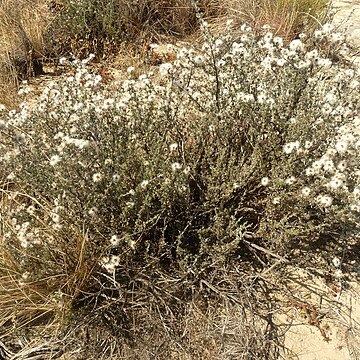Much-branched, rigid shrubs, 0.3-0.6 m high. Old stems and branches bare, sometimes spinescent, red-brown to grey-brown; young branches initially shortly hairy, soon glabrous. Leaves opposite, densely imbricate on brachyblasts, linear to triangular, 2-9 mm long, semi-rounded, abaxially slightly keeled, adaxially basally slightly flattened, entire, permanently silvery sericeous, silvery white, apex acute, base broadened, amplexicaul. Capitula heterogamous radiate, mainly solitary, terminal on brachyblasts, rarely 51-102 mm terminal racemes, 5-12 x 3-8 mm, sessile or subsessile(peduncles shorter than 0.5 mm). Involucral bracts 4, broadly ovate, 4-6 x 3-5 mm, outer 2 slightly flattened, inner 2 more keeled, margin purple, abaxially sericeous, apex obtuse, rarely acute. Paleae: those of marginal florets partly or entirely connate forming a cylindrical tube, glabrous except for apex; those of disc florets narrowly oblong to lanceolate, 6-7 x ±1 mm, membranous, acute, long-pilose on margins, ab-and adaxial surfaces glabrous. Rays 3 or 4; lamina broadly oblong or oblong-cuneate, 5-8 x 3-6 mm, many-veined, glandular abaxially, pale to dark red-purple or white, obtuse, 3-dentate, tubular part narrowly cylindrical, 2-3 mm long. Style branches flattened, linear, 2.0-3.5 mm long. Ovary slightly lanceolate-flattened, densely hairy. Seed ovoid, slightly flattened, 3 mm long. Disc florets 26-35, functionally male with sterile ovary; corolla tubular, widening in upper third, 6-8 mm long; glandular abaxially; corolla lobes acute, 0.5 mm long. Stamens 5, up to 4 mm long. Style unbranched, with slightly convex apex surrounded by short, sweeping hairs. Receptacle after anthesis with white, long-pilose indumentum between involucral bracts and connate marginal paleae. Flowering time: correlated with rainfall, January to April in summer-rainfall areas, July to August in winter-rainfall areas.
More
Shrub, 0.3-0.6 m high; much branched, rigid, sometimes spinescent. Leaves opposite, densely imbricate; blade linear to triangular, margins entire, permanently silvery sericeous. Heads radiate, solitary, terminal, rarely 2-4 in terminal racemes, sessile or subsessile. Involucral bracts 4, broadly ovate, margins purple. Receptacle with paleae of ray florets partly or entirely connate, forming a tube. Flowers: ray florets 3 or 4, white or pale to dark red-purple; disc florets 26-35, corolla tubular, widening in upper part, yellow, lobes sometimes purplish; May, Sep. Fruit with cypsela ovoid, flattened, densely hairy. Pappus absent.
Much-branched, rigid shrub, 0.3-0.6 m high, sometimes spinescent. Leaves opposite, densely imbricate, linear, entire, permanently silvery sericeous. Capitula radiate, solitary, terminal, rarely 2-4 in terminal racemes, sessile or subsessile; involucral bracts 4, broadly ovate, margins purple. Receptacle paleate, those of ray florets partly or totally connate, glabrous but long-pilose on margins, those of disc florets free. Ray florets 3 or 4, white or pale to dark red-purple. Disc florets 26-35, tubular, widening in upper part. Flowering time Feb.-Aug., Dec. Pappus absent. Cypselae lanceolate to ovoid, flattened, densely hairy.
Rigid shrublet, 0.3-0.6 m tall. Leaves on short-shoots, linear-triangular, 2-9 mm long, silvery silky. Flowerheads mainly solitary, subsessile, radiate, 5-7 mm long; involucral bracts 4, silky; ray florets 3 or 4, white or pale to dark maroon, 5-8 mm long; marginal paleae ± connate into a tube, glabrous except for margin.

